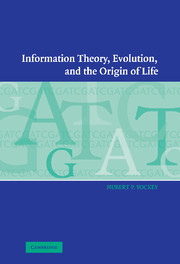Book contents
- Frontmatter
- Contents
- Preface
- 1 The genetic information system
- 2 James Watson, Francis Crick, George Gamow, and the genetic code
- 3 The Central Dogma of molecular biology
- 4 The measure of the information content in the genetic message
- 5 Communication of information from the genome to the proteome
- 6 The information content or complexity of protein families
- 7 Evolution of the genetic code and its modern characteristics
- 8 Haeckel's Urschleim and the role of the Central Dogma in the origin of life
- 9 Philosophical approaches to the origin of life
- 10 The error catastrophe and the hypercycles of Eigen and Schuster
- 11 Randomness, complexity, the unknowable, and the impossible
- 12 Does evolution need an intelligent designer?
- 13 Epilogue
- Mathematical appendix
- Glossary
- References
- Index
9 - Philosophical approaches to the origin of life
Published online by Cambridge University Press: 15 August 2009
- Frontmatter
- Contents
- Preface
- 1 The genetic information system
- 2 James Watson, Francis Crick, George Gamow, and the genetic code
- 3 The Central Dogma of molecular biology
- 4 The measure of the information content in the genetic message
- 5 Communication of information from the genome to the proteome
- 6 The information content or complexity of protein families
- 7 Evolution of the genetic code and its modern characteristics
- 8 Haeckel's Urschleim and the role of the Central Dogma in the origin of life
- 9 Philosophical approaches to the origin of life
- 10 The error catastrophe and the hypercycles of Eigen and Schuster
- 11 Randomness, complexity, the unknowable, and the impossible
- 12 Does evolution need an intelligent designer?
- 13 Epilogue
- Mathematical appendix
- Glossary
- References
- Index
Summary
The standard model of the origin of life on Earth was first given form by Oparin (Oparin 1957) and Haldane and begins with the abiotic production of organic molecules. Abiotic chemical evolution is then thought to occur in the presence of liquid water, resulting in more complex structures leading to life itself and the onset of abiological evolution. The standard model for the origin of life posits that life is a naturally emergent property of matter in Earth-like environments and would develop rapidly on any similar body.
Christopher P. McKay in his ISSOL Urey Prize Lecture at NASA: Planetary Evolution and the Origin of Life (1989). NASA Space Sciences Division, Urey Prize Lecture, also in Icarus, 91, 93–100 (1991)Vitalism
Vitalism is the belief that there is a metaphysical, supernatural, nonmaterial, idealist élan vital, a life force that distinguishes living from nonliving matter. Vitalism has its roots in the German idealist philosophy of Georg Wilhelm Friedrich Hegel (1770–1831), F.W.A. Schelling (1775–1854), and L. Oken (1779–1851) in the nineteenth century, members of a romantic philosophic movement, Naturphilosophie, who believed all creation was a manifestation of a World Spirit. They believed all matter possessed this Spirit and organized bodies had it to an intense degree. In the nineteenth century, it was quite possible to be a vitalist, believing in a vital force or élan vital, without thinking of the vital force being supernatural.
- Type
- Chapter
- Information
- Information Theory, Evolution, and the Origin of Life , pp. 149 - 157Publisher: Cambridge University PressPrint publication year: 2005



